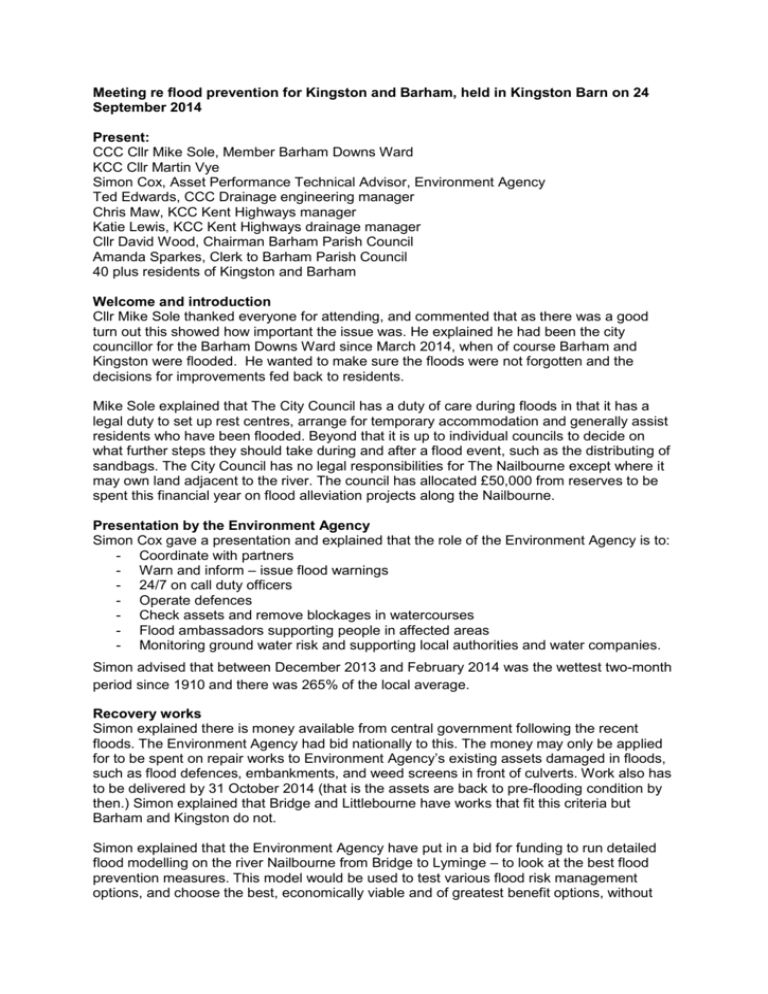Minutes - Barham Parish Council
advertisement

Meeting re flood prevention for Kingston and Barham, held in Kingston Barn on 24 September 2014 Present: CCC Cllr Mike Sole, Member Barham Downs Ward KCC Cllr Martin Vye Simon Cox, Asset Performance Technical Advisor, Environment Agency Ted Edwards, CCC Drainage engineering manager Chris Maw, KCC Kent Highways manager Katie Lewis, KCC Kent Highways drainage manager Cllr David Wood, Chairman Barham Parish Council Amanda Sparkes, Clerk to Barham Parish Council 40 plus residents of Kingston and Barham Welcome and introduction Cllr Mike Sole thanked everyone for attending, and commented that as there was a good turn out this showed how important the issue was. He explained he had been the city councillor for the Barham Downs Ward since March 2014, when of course Barham and Kingston were flooded. He wanted to make sure the floods were not forgotten and the decisions for improvements fed back to residents. Mike Sole explained that The City Council has a duty of care during floods in that it has a legal duty to set up rest centres, arrange for temporary accommodation and generally assist residents who have been flooded. Beyond that it is up to individual councils to decide on what further steps they should take during and after a flood event, such as the distributing of sandbags. The City Council has no legal responsibilities for The Nailbourne except where it may own land adjacent to the river. The council has allocated £50,000 from reserves to be spent this financial year on flood alleviation projects along the Nailbourne. Presentation by the Environment Agency Simon Cox gave a presentation and explained that the role of the Environment Agency is to: - Coordinate with partners - Warn and inform – issue flood warnings - 24/7 on call duty officers - Operate defences - Check assets and remove blockages in watercourses - Flood ambassadors supporting people in affected areas - Monitoring ground water risk and supporting local authorities and water companies. Simon advised that between December 2013 and February 2014 was the wettest two-month period since 1910 and there was 265% of the local average. Recovery works Simon explained there is money available from central government following the recent floods. The Environment Agency had bid nationally to this. The money may only be applied for to be spent on repair works to Environment Agency’s existing assets damaged in floods, such as flood defences, embankments, and weed screens in front of culverts. Work also has to be delivered by 31 October 2014 (that is the assets are back to pre-flooding condition by then.) Simon explained that Bridge and Littlebourne have works that fit this criteria but Barham and Kingston do not. Simon explained that the Environment Agency have put in a bid for funding to run detailed flood modelling on the river Nailbourne from Bridge to Lyminge – to look at the best flood prevention measures. This model would be used to test various flood risk management options, and choose the best, economically viable and of greatest benefit options, without increasing risk to others. Simon explained they should know the outcome of the bid for this modelling exercise by the end of the year. Existing flood risk measures There is a management group covering the Litte Stour, Nailbourne and Petham Bourne areas. The meeting then went on to feedback on specific areas of concern: Railway Hill During the flooding there were still a lot of 4x4s on the South Barham Road going to the Causeway and these created wash and damage to properties. Kent Highways are proposing to put up a gate that can be closed quickly to prevent vehicular access. (A resident with nearby access agreed to speak to Chris Maw separately – a solution may be that the resident is given a key to allow access.) Kent Highways also plan some works to scale out part of the road. Ted Edwards advised the city council put out 3000 sand bags along South Barham Road across Railway Hill and through to The Causeway He explained that the city council bid £50k and KCC have given a further £50k for some temporary measures to be undertaken along the full length of the Nailbourne by the end of January. At Derringstone they are looking at a system called ‘flood stop’ – a temporary flood defence (that has been used successfully at Sandwich) to replace the need for sandbags made up of big plastic boxes linked together and filled with water. These can be installed in 3-4 hours and be up to 50cm in height. They are not cheap and are difficult to store and will cost £10-£12k for this length. The city council will store them and bring out when needed. A dwarf wall at the upper end by the Barn house is also being looked into. The Railway Hill footbridge is a listed structure, owned and maintained by Kent Structures. Flows are impeded by it and the problem is lack of access as the ford is not passable. Canterbury City Council are talking to English Heritage about an option to cut off the top of the bridge and building it up higher to allow more flow below. English Heritage may say no to this option, plus there is no funding in place for it yet, and it would be subject to a planning application consent. Other options could be to close the Causeway but some residents are against this. Or leave the Causeway open and lower the area by the footbridge but that would then impede pedestrians. Or to look at whether the bridge can be completely removed and replaced as is elsewhere for prosperity. KCC, Kent Highways and Canterbury City Council are committed to finding a solution, although none of the above would be in place by the end of 2014. If approval is given, Chris Maw advised the works could be done next summer, funding permitting. He did not think there was any utility apparatus beneath to slow things down. All options were being kept open until the English Heritage response is given. A resident asked if the bridge was raised whether there would still be something done with The Causeway. Chris Maw replied he was not sure, the structures team were looking at this. A resident commented that the road profile by the bridge has been changed over the years – the road could be reshaped to help the river flow more freely. However the reply given explained that to deepen it would only delay the point at which it reaches capacity. A resident explained he had been in talks with the city council’s conservation officer and on removing a flower bed he found four inches of tarmac. Since 1910 the road has been raised by over nine inches by highways works. Surely to lower the road would alleviate the problem? Chris Maw explained there is utility apparatus at a certain depth and to change the height is massively expensive, plus there would be associated costs to lower kerbs. He confirmed they have not looked at this suggestion as an option. A resident stated that in 1996 the road by the ford was raised about 15 inches and this has caused the problems with the bridge flow. Ted Edwards replied that to lower the road would marginally increase the velocity but the culvert will still hold it back. In answer to a question Chris Maw confirmed that Kent Highways were not going to raise the levels of South Barham Road – but would be scouring out and doing patching repairs to the same level. They would not be overlaying any sections. In response to further residents’ concerns he agreed to check certain existing higher points. A further flood prevention measure is for a bund at the back of Derringstone House, although this would be a long term option. Cllr David Wood advised that access out from Railway Hill is poorly maintained with severe potholes and this is more problematic when it’s flooded. Out Elmstead Lane There is the possibility to build a bund upstream along Valley Road, although the Environment Agency are not sure how effective this might be and it needs further investigation. Or an additional culvert alongside. Residents of Out Elmstead Lane have problems with access when the road is closed – exiting on to the A2 at the top without an acceleration lane. Chris Maw explained he is talking to the Highways Agency but they do not think they can get an acceleration lane in, but maybe some warning signs and road markings could be provided, together with vegetation cut back. There may also be some scope about a temporary speed limit or temporary acceleration lane during periods of road closure. Chris Maw advised he would like to have some mechanism in place by January 2015. Sandbags at the bottom of Out Elmstead Lane create a physical barrier for residents to get out to take a bus. Chris Maw advised that he had seen photos of the temporary bridge that had been provided during the floods of 2000, and he was looking to be able to do a similar structure for future need. A resident commented that with ground water flooding there is enough notice time. Another resident commented that the sandbags had been left at the bottom of Out Elmstead Lane for too long after normal levels had resumed. Chris Maw and Simon Cox confirmed their comments had been taken on board, subject to all road users being taken in to account, and that the multi-agencies are all adding data and refining their operational plans. A resident commented that there had been no sandbags in 2000 at the bottom of Out Elmstead Lane. Chris Maw advised they were placed with the intention to keep the arterial route open to ensure services could still access the village. However all options would be looked at, within budget constraints. A resident asked about the reinstatement of the green cats’ eyes at the top of Out Elmstead Lane, taken away before the flooding, and Chris Maw confirmed he had talked to the Highways Agency about them. A resident asked about the stretch of Valley Road, from Out Elmstead Lane to the Black Robin public house, and whether the whole road could be lifted by about 18 inches, as water comes up from the ground. Chris Maw advised this would be a massive construction to raise the road up and was not infact as easy as it sounds. Ted Edwards advised that several culverts were installed in 2001, in areas deemed to be of greatest need. If the size of the culvert at Out Elmstead Lane was increased this would impact down river at the Black Robin and possibly put properties at risk. Junction of The Street, Barham and Valley Road The issues here are lack of capacity in the culvert and surface water issues on the hill. Simon Cox advised they are looking at creating a small bund here. The Old Post Office flooded from the front and the hotelier next door flooded from the side. Kent Highways are planning works for this area, to complete by Christmas. Katie Lewis advised Kent Highways are looking at attenuation measures also longer term under the playing field. Cllr David Wood advised the village green status of the playing field may have some restrictions. Kingston – Black Robin public house The culvert under the road here is undersize in extreme events, but it is very expensive to place it and the multi-agencies are looking to see if a bund would help here. A resident commented that the water flows through the culvert but there is restrictions by the pub as there is concrete in the river bed. There is also unconsented decking that does increase the flood risk – the environment agency are in discussions with the owner to modify this. Other comments KCC Cllr Martin Vye asked if the Minutes of the multi-agency meetings may be shared with the relevant parish councils. He also spoke of a meeting held in February that had looked at ‘holding areas’ further up the valley – possibly on land at Elham? Simon Cox explained it was a big scheme and they would need to be clear about whether it would work and the costs involved. If the bid for modelling is successful they would look further at this as a long term option. It would be difficult with ground water type flooding to store it for months though. A resident asked if there was any help for people with ground water flooding through the floors of their homes. Ted Edwards replied no, however a resident said the agencies should talk to Southern Water about extracting water. They have a controlled system for the water table. The resident stated they extracted too much after the 2000 floods and were piping water across to France. Simon Cox confirmed Southern Water is at multi-agency meetings and he agreed to follow up this point. A long term fix to reduce the flow rate and lower the aquifer level for example by pumping out to sea was also suggested, and Simon confirmed nothing was off the table, but it would depend on the outcome of the bid, when all possible solutions and scenarios could be modelled. Dredging Simon Cox confirmed that there is a three year programme with central government for areas that would benefit from dredging. Barham and Kingston have been added to this, and the outcome of the programme is awaited to see which areas put forward have been given approval. A resident mentioned that in the field between Out Elmstead Lane and the Black Robin there are several springs that have recently bubbled up – will dredging make these worse? Ted Edwards said that he understood that dredging would be done by the Environment Agency where it would help such as at pinch points and for shingle in culverts. Insurance Company problems In answer to a question, Ted Edwards advised he could be contacted to write letters of support for residents affected by flooding and in negotiation with their insurance companies. Drains Katie Lewis advised that Kent Highways cannot do all the drains as they simply do not have enough resource, but they are to target and jet the worst ones in November 2014. Water quality/contamination Ted Edwards explained that Southern Water have done a lot of improvements over the last 2-3 years to prevent sewage entering the water supply. They have spent millions sealing leaks in the main sewer but when water levels are very high it can’t cope. Southern Water are now sealing some of the lateral sewer pipes. During the 2014 floods Southern Water did supply mini treatment plants to deal with the problem. Thanks for multi-agency support Residents of The Barn, South Barham Road thanked the multi-agencies for their support during the 2014 floods, and sought a reassurance that they would receive help if needed again. Everyone confirmed a commitment to a multi-agency response again. Residents can – and did – help out too. Ted Edwards explained that KCC’s Emergency and Resilience team are reinvigorating the Community Flood Wardens programme, and a four hour training course is to be held on 11 October. Ted is to attend this and he invited interested residents to contact him to find out more and attend the session. Cllr Mike Sole thanked everyone for attending and for their input and the meeting closed at 9.10pm.







